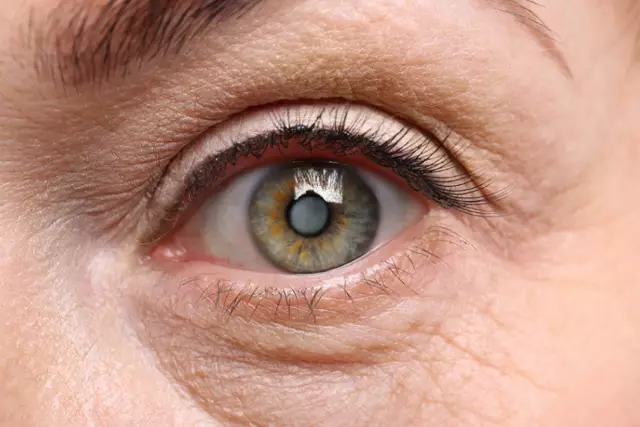- Author Rachel Wainwright [email protected].
- Public 2023-12-15 07:39.
- Last modified 2025-11-02 20:14.
Milk glands
The mammary glands are paired glandular organs, which in women after childbirth form milk, and in men they remain underdeveloped.

Breast structure
The size and shape of the glands are individual, depending on age, the degree of development of external sexual characteristics, and the menstrual cycle. On the anterior surface of the chest, they are located anterior to the pectoralis major and serratus anterior muscles.
Each mammary gland contains 15-25 glandular lobules, separated by layers of connective tissue and adipose tissue, in which nerves and blood vessels pass. The glands end in ducts that converge radially towards the nipple and open at the top of the nipple. In the final segment of the milk ducts, there are dilations - the lactiferous sinuses, which serve as a kind of reservoir for milk formed in the alveoli.
The nipple and areola are pigmented and have many nerve endings. On the areola, sweat and sebaceous glands open in the form of tubercles. The mammary glands are supplied with blood by an extensive network of vessels.
Breast examination
The study of the organ begins with a question about the timing of puberty, the formation of menstruation, the number of pregnancies, childbirth, whether the woman breastfed after childbirth and for how long, about hereditary burden of tumor lesions of the glands. A woman may complain that the mammary gland hurts or there is discharge from the nipple.
After questioning, the mammary gland is carefully examined in a vertical and horizontal position. On examination, the size, shape, symmetry of the location of the glands, swelling of the mammary glands, the condition of the nipple and areola, the degree of displacement of the mammary glands when moving with the hands, the vasculature on the skin are assessed.
Sliding palpation of the mammary glands allows you to assess their mobility in relation to the skin and underlying tissues, to identify pathological discharge from the nipple, nipple deformities, and areola compaction. Be sure to study the lymph nodes associated with the glands - axillary and subclavian.
Transillumination of the glands helps to detect pathological foci in them. A more informative method of research is ultrasound, it is recommended to carry out it if there is a suspicion of a disease of the mammary glands in women under 30 years old, at an older age mammography is indicated. In case of pathology, on x-rays with mammography, darkening is found, the size and location of which can be accurately determined.
Breast diseases and treatment approaches
The following pathological processes can affect the mammary gland:
- Inflammatory and infectious;
- Dyshormonal;
- Tumor;
- Traumatic injuries.
Mastitis is an inflammatory disease that most often develops in women during breastfeeding. Pathogenic bacteria (staphylococci, streptococci, etc.) enter the mammary gland through the ducts or through cracks in the nipples, causing inflammation in it. The disease proceeds against the background of a woman's poor health, high body temperature, there is a swelling of the mammary glands and an increase in their size, when palpating, seals and soreness are determined. With the transition of inflammation to the purulent phase, there may be local redness and softening on the skin. Treatment of the mammary gland with mastitis is carried out under the supervision of a surgeon, starting with conservative measures, antibiotics and detoxification must be included. With purulent mastitis, surgical intervention is required.
Other infectious and inflammatory lesions of the glands include thrombophlebitis of their venous network, tuberculosis, echinococcosis, etc.
Galactorrhea - voluntary milk flow from the mammary glands. This is a fairly frequent and completely physiological phenomenon during lactation, when when one breast is sucked from the other, milk begins to flow, as a sign of the establishment of lactation at a sufficient level. If milk is secreted outside the period of breastfeeding, then this is a pathology associated with hormonal imbalance and increased production of the hormone prolactin. Treatment of the mammary glands in this case is based on restoring hormonal balance, carried out in conjunction with an endocrinologist.
Benign and malignant processes are distinguished from tumor diseases of the mammary glands. Benign include fibrocystic mastopathy and fibroadenoma. In these conditions, the mammary gland hurts depending on the phase of the menstrual cycle. Treatment at the initial stages includes hormonal, homeopathic remedies, later surgery is required with sectoral resection of a part of the gland, removal of the entire breast, as a rule, not required.
Of the malignant lesions, cancer is in the first place. In its occurrence, heredity, the age of the first pregnancy, the duration of breastfeeding, etc. play a role. The danger of breast cancer lies in the rapid spread of metastases. A prolonged asymptomatic period leads to late detection of pathology. Most often, a tumor is discovered by a woman by accident, while changing clothes, washing the body. Basically, the process affects only one gland, in the second there are already tumor metastases.
The most common are nodular and diffuse lesions. Nodular cancer is usually localized in the central zone and the upper outer quadrant, you can feel a mobile dense rounded formation with clear edges. Above it there may be skin changes in the form of pastiness, "lemon peel", nipple retraction. Diffuse cancer is not palpable clearly, with its various varieties, the mobility of the skin may decrease, and the mammary gland shrinks and shrinks. Cytological and histological examination of a biopsy specimen plays a decisive role in the diagnosis.
Approaches to cancer therapy depend on the stage - in the early stages, only surgical removal of the breast is possible, in the remaining stages it is required to combine it with radiation and chemotherapy.
Found a mistake in the text? Select it and press Ctrl + Enter.






